Continuing with an on-and-off series of song lists featuring—in the picturisation—various types of musical instruments. This began with my post on women pianists, followed much later by a post on male pianists, and then a post on songs that featured string instruments. It’s time, I decided, to try and compile a list of good songs that feature another important category of musical instruments: percussion instruments.
The word ‘percussion’ dates back to the early 15th century and is derived from the Latin percussionem (a beating or striking). This gives an indication of what percussion instruments are all about: they produce sound by being struck—by sticks, by hands, against each other. It is believed that percussion instruments were, after the human voice, probably the first form of musical instruments to be invented. They include a vast range of instruments, all the way from different types of drums to cymbals, triangles, tambourines, castanets, and more.
But, without further ado: my list. In keeping with my self-imposed rules for the previous ‘musical instruments’ posts I’ve compiled, I’ll restrict the songs in this list to only those songs where the person playing the percussion instrument also sings (which is why one of my old favourites—Madhuban mein Radhika naache re—won’t find a mention here, even though the tabla there is superb). And, to make it slightly less of a walk in the park for myself, I’ve made sure that each of these ten songs feature a different percussion instrument. As always, the songs are all from pre-70s films that I’ve seen.
Here we go, then, in no particular order:
1. Dhol. Hariyaala saawan dhol bajaata aaya (Do Bigha Zameen, 1953): It seemed appropriate to start this list with a song that doesn’t just feature a percussion instrument, but the lyrics of which too mention the instrument: the dhol. An almost must-have for folk music in North and Central India (with variants in other parts of the country, such as the pung of Manipur), the dhol is a large double-headed drum which is slung by a strap or string around the player’s neck, making it a portable instrument. Since the dhol allows relative freedom of movement, it also allows players to not just walk while playing, but even dance (bhangra is one form where this can be seen). The dhol, incidentally, is the intermediate (as far as size is concerned) of three related instruments, the dholak being the largest and the dholki the smallest.
Hariyaala saawan dhol bajaata aaya is a vibrant, joyful song that celebrates the monsoon—and remains true to the very rural theme of Do Bigha Zameen by using distinctly folk instruments. The dhol is very much in evidence here, played by one of the men who lip-synchs to Manna Dey’s voice. And the word dhol itself is used in the song to signify the thunder, drumming and thumping and announcing the arrival of the monsoon. Interestingly, another of my favourite monsoon songs, Umad-ghumadkar aayi re ghata, also has a dhol being used.
2. Dholki. Jogi hum toh lut gaye (Shaheed, 1965): Very similar to the dhol, but smaller, is the dholki: also a double headed drum which is popular in folk music. One of the most common appearances of the dholki is in Punjabi wedding sangeet (in fact, it’s such an integral part of sangeet that in parts of Pakistan the sangeet celebration itself is called the dholki).
So the song I’ve picked is one, fittingly, from a filmi sangeet. Jogi hum toh lut gaye is quintessential Punjabi wedding sangeet song: the women sit around and sing. The main singer (played by Sarita) sings of falling in love and being devastated as a result of that love, knowing full well that the man she is addressing can actually hear her, since he’s there among the male guests entering the courtyard. You can see here the typical use of the dholki: its drumheads being beaten with the palms while a spoon hitting the side lends a contrasting rhythmic peal.
3. Tabla. Jaa tose nahin boloon Kanhaiyya (Parivaar, 1956): Or rather (according to Wikipedia), the tabla and the baya or dagga—the tabla being the drum on the right and the baya or dagga the drum on the left; the two hand drums together form a composite instrument. Popular legend has it that Amir Khusro invented the tabla sometime in the 13th century by sawing a dholak in half, but since ancient carvings from much earlier do show musicians using tablas, this is almost certainly just a popular myth. Whatever it may be, the tabla has long been a very integral part of Hindustani music. This is, to put it technically, a membraphone percussion instrument (in which the sound is produced by striking a vibrating membrane—in the case of the tabla, usually goatskin).
Tablas appear aplenty in Hindi film songs, especially in classical ones. Almost no dance performance is complete without a tabla being among the accompaniments. And here is a dance performance—a sweetly domestic one, with the wife (Sabita Chatterjee) dancing while her husband (played by Ashim Kumar) doesn’t just play the tabla, but also sings. This is a lovely song—classic Salil Choudhary—and the tabla is very prominent in the music, too.
4. Daf. Dil ka haal sune dilwaala (Shree 420, 1955): The daf, also known as dafli, is a type of frame drum—the width or diameter of the frame across which the vibrating membrane is stretched is much larger than the depth of the drum. This means that the daf can be easily held in one hand, while the other is used to beat the drumhead. The daf is originally from Persia, and was known even in pre-Islamic Persia. Today it is well-known as an instrument across Central Asia and the Indian sub-continent, especially in (unsurprisingly) Iran, Turkey, the Middle East, Azerbaijan, etc.
Hindi film songs feature their fair share of dafs: they appear in several folksy songs as well as in the über patriotic Dulhan chali pehen chali from Purab aur Pachhim. My favourite daf song, however, is the delightful satirical Dil ka haal sune dilwaala. Raj Kapoor carries his daf all through the song, using it as a prop to sing of corruption and nepotism and all the other ills that plague the lives of the poor. A superb song, and a fine display of a daf.
5. Castanets. Thodi der ke liye mere ho jaao (Akeli Mat Jaiyo, 1963): A change, now, from the rather more ‘Indian’ percussion instruments (though the dhol and its variations as well as the tabla aren’t merely Indian, but well-known in other parts of Asia as well, including the Middle East). Castanets are common in more Western music, especially Latin and Moorish. They are an idiophone percussion instrument: the entire instrument produces the sound, rather than the sound being produced by the vibration of a particular part such as a drumhead. Castanets produce a distinctive clicking sound which has been used very effectively in several very well-known Hindi songs (do check out rsbaab’s informative and very interesting post on this—there were some surprises here for me).
Since castanets fold so easily into the player’s hands, they can be a little hard to spot in picturisations. Here’s one song, though, that does show them, even if only briefly: Minoo Mumtaz begins Thodi der ke liye mere ho jaao with castanets. They disappear shortly afterwards—in fact, even before she actually launches into her song—but that brilliant clicking continues to dominate the song, so one can only assume that she’s tossed them to some musician who carries on from where she left off.
6. Manjeeras. Aan milo aan milo Shyaam saanwre (Devdas, 1955): Like castanets, manjeeras are small, handheld percussion instruments—in this case, ‘clash cymbals’ (cymbals that produce a sound by clashing together). Manjeeras are similar to the taal, which is a larger version of the same instrument, used mostly in Assam. Both are frequently used in devotional music, which is why they are often seen in picturisations of bhajans.
…and this one, one of the very few bhajans that I really like, features manjeeras. Dulari holds a pair of them throughout the song, gently clinking them together to create the soft tinkling that forms the backdrop to the vocals of Aan milo aan milo Shyaam saanwre.
7. Tambourine. Yamma yamma yamma tu parwaana main shamma (China Town, 1962): The tambourine is very similar to the daf or dafli in that it consists of a shallow ‘frame drum’ which is held in one hand while being struck with the palm or fingers of the other hand. Where the tambourine differs is in that its frame has metallic rings (called zils) inserted into it, allowing for the addition of a jingling sound. Some tambourines, interestingly, lack the drum head and only have the metal element, making it a purely ‘jingling’ instrument.
The tambourine is very prominent in Yamma yamma yamma tu parwaana main shamma: the song itself begins with a close-up of the tambourine held in Helen’s hand, before she swirls away. After that, other than a brief interlude right after the introduction, Helen dances throughout with the tambourine in her hand. True, it doesn’t look as if she’s really even pretending to play it (how much sound can be produced, after all, with just a forefinger lightly tapping the drumhead?), but the tambourine is here in all its glory, trailing ribbons and all.
8. Sapp. Ainwein duniya dewe duhaayi (Jaagte Raho, 1956): Also known as the chhikka, the sapp is a percussion instrument from Punjab. It’s unmistakable in appearance, since it consists of a series of X-shaped wooden strips joined to each other at their ends and along the middle, rather like the struts on a suspension bridge. The sapp, which is played by pulling apart and pushing together the far ends of the instrument, produces a clapping sound which often accompanies Punjabi folk dances like the gidda and bhangra…
…which is probably why it appears in Ainwein duniya dewe duhaayi. Bhangra exponent Manohar Deepak performs here with his troupe, in this song about corruption and lies and dishonesty. While the sapp is in the hands of one of the ‘chorus’ through most of the song, Deepak takes it into his own hands near the end of the song, and sings with it while dancing.
9. Acoustic drum set. Dil deke dekho dil deke dekho (Dil Deke Dekho, 1959): Not one type of drum, actually, but a set of different drums set up in such a way that they can be played by a single player. These can include over a dozen pieces, ranging from the bass drum (the type on which you see, in old club songs, emblazoned the name of the band: Ted Lyons and His Cubs, The Monkees), floor toms, hanging toms, cymbals, and more (even tambourines, in extended sets). The acoustic drum set is something you see very frequently in Hindi club songs: if an orchestra is shown, there’s invariably one of these around.
Shammi Kapoor played the role of a musician in at least two of his major films—Dil Deke Dekho and Teesri Manzil, and in the title song of Dil Deke Dekho, he spends all his time sitting at an acoustic drum set, singing and playing. The focus isn’t on him all the time—it shifts to the dancers, to Asha Parekh’s friends and the rest of the audience—and even when it returns to him, it’s often just on his face. But there are frames in which he’s ‘playing’ the drums, all right.
10. Maracas. Ghoomke aaya hoon main bandhu (Basant, 1960): Maracas, so very much a part of Latin American music, are (like castanets) idiophone percussion instruments (or ‘side percussion’ instruments, as opposed to the main percussion instruments, like drums). Also known as rumba shakers, maracas are rattles, traditionally made from hollow gourds filled with dried seeds or beans. They are held in pairs, one maraca in each hand, and shaken to produce a pleasing jingle-jingle sound.
I haven’t seen maracas in too many Hindi film songs. One where they do appear—played by a little boy—is the song Dil se milaake dil pyaar kijiye, from Taxi Driver. And here, in Ghoomke aaya hoon main bandhu. Although Johnny Walker enters the scene wielding drum sticks on a large drum, that disappears within moments and he spends the rest of the song holding (not really playing) what looks like a trombone. His companion and colleague, played by Kammo, however carries a pair of maracas nearly all through the song and shakes them every now and then.
There are literally dozens of percussion instrument film songs out there, with dhols and dholaks being among the most frequently seen. Look at, for instance, a song like Honthon mein aisi baat from Jewel Thief (from which the introductory screen shot for this post is taken). That song is almost a showcase of drums: from large dhol-like ones held by the dancers, to the tapered drum Dev Anand holds and plays with his hands, to massive stationary drums played with sticks—and even kettle drums. Not to mention a couple of others. I didn’t include that song because the only drummer who does sing a bit is Dev Anand, and his “Shalu” or the occasional “Ho!” doesn’t really count as full-fledged singing, in my opinion.
But, as I mentioned, there are dozens more which do fulfill the criteria I set forth. Which are your favourites?


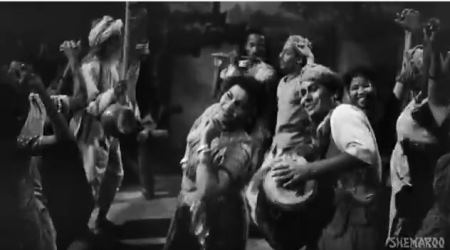
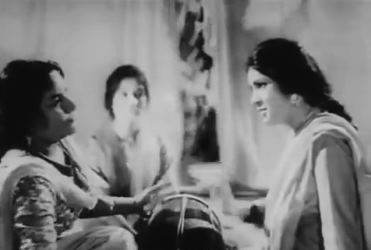
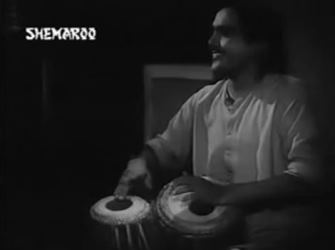
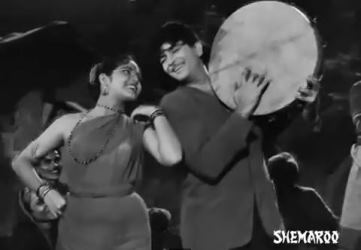
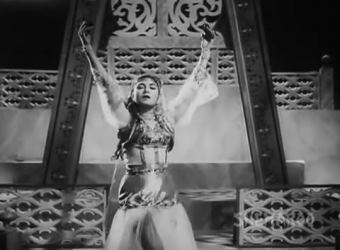
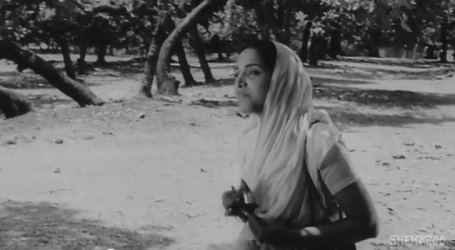
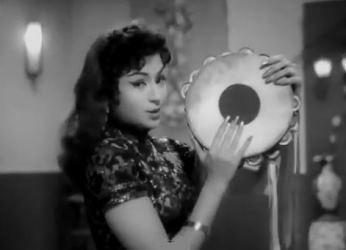
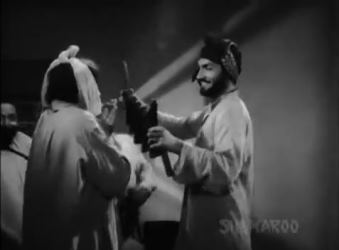
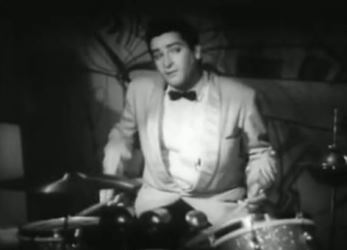
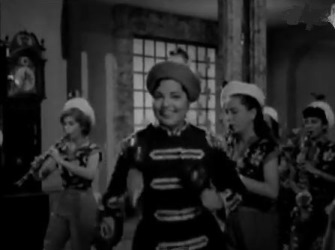
These are fabulous. No wonder these songs are all classics, it’s because they use these traditional instruments, off screen and on screen.
I am going to enjoy myself listening to all these songs.
Meri pyari beheniya has been overplayed, yet I love it. So here is my contribution.
http://www.youtube.com/watch?v=9G6gBFrrpDQ
LikeLike
Thank you, Ava! Glad you liked that. :-) Meri pyaari beheniya banegi dulhaniya had been on my long list, but it was sort of on the back burner: I kept telling myself I’d use it only if I couldn’t find another song that i didn’t like more. Good to see you put it in.
LikeLiked by 1 person
There was Raj Kapoor playing the ? Dholak in the “Dil hi to hai” song, “Laaga chunri me daag”.
LikeLike
Nice compilation. Similar to the CASTANETS, there is a Rajasthani folk instrument called the KHARTAL. This is a set of four wooden rectangular pieces, two of which fits into each hand and when played, produces the same clicking sound.
I didn’t find any Hindi song which used this KHARTAL.
Let me know if you do..
LikeLike
Thank you for that. I do know about the khartal, but like you, I too don’t recall seeing any song featuring it… perhaps something from a film set in Rajasthan? It’s a long shot, but might be possible.
LikeLike
I like this song as well, it has several instruments, a manjeera like thing and dhol of course.
https://www.youtube.com/watch?v=ppu3UDLWCf8
LikeLike
I love Ghanan ghanan – such a lovely song! All these folksy songs celebrating the monsoon seem to be the perfect setting for percussion instruments. Both in the picturisation, as well as in the orchestration – the thunder is so brilliantly depicted through drums.
LikeLiked by 1 person
I put the link in because I know you could not use it, it being from a movie post the 1970s. :)
LikeLike
True, that’s there too. :-) I keep forgetting that Sachcha Jhootha is from the early 1970s, not from the late 1960s.
LikeLiked by 1 person
Wonderful collection ! Enjoyed it very much. One of my favorites is played on Matka or Ghada. “Guzari thi raat aadhi” from Surang. A very young Shashikala and so adept at playing the Matka. Watch her fingers.
http://youtu.be/dwAfR5AsXzw
LikeLike
I love this song, Lata’s singing, the simplicity of the whole scene. And Shashikala stands out in terms of her look and how adept she is on the maTka.
LikeLike
Wow. I am very impressed. I had never heard this song before, let alone seen it. While the song itself is lovely – beautiful music and well rendered – what I find really commendable is Shashikala’s handling of the gharha. One of the very instances, I would think, of an actor actually seeming to play the instrument in question rather than just haphazardly pounding away at it.
LikeLike
Thanks for this post, I haven’t heard some songs before. And I love Jogi hum toh lut gaye – it is so beautiful!
My all time favorite tabla song is Piya Baawri from Khoobsurat – Ashok is amazing with tablas!
And surely Aye Meri Zohra Jabeen with Achala Sachdev with tablas.
LikeLike
Thank you, Anna! I’m glad you liked this post. I do especially love Jogi hum toh lut gaye too, it’s such a lovely little song (and the words are very sweet).
Piya baawri is wonderful. Years since I heard that song. Oh, and Achla Sachdev plays the dholki in Ae meri zohrajabeen, not the tabla. Another favourite song of mine, though I couldn’t include it here, since her character only plays the instrument, doesn’t sing.
LikeLike
Very nice list Madhu!
Sadhana playing in the second antara
Aayi aayi basanti bela had a few permission instruments on screen too.
LikeLike
Thank you, Karthik! Glad you liked that. And thank you for Bahut shukriya badi meherbaani. That had been on my shortlist too, but I eventually dropped it because I intend to put that song on another list coming up sometime in the near future. ;-) What a gorgeous song, though. Ek Musaafir Ek Haseena had such a great score: some of my favourite romantic songs.
LikeLike
What a lovely informative post, Madhu! Thank you.
I did not know that the instrument played in the Jagte Raho song was called a sapp.
When I read the title of your post, four songs came to my mind. Three of them (Yamma yamma, Dil deke dekho and Dil ka haal sune dilwala) are listed here, and the fourth (Honthon pe aisi baat) gets a mention. :-)
The only other song I can think of at the moment is Bahut shukriya badi meherbaani (where Sadhana plays the dholki (?) for a bit.)
LikeLike
Thank you, Harini! Glad you liked the post. To be honest, I hadn’t known that instrument was called a sapp either… I learnt it only when doing my research for this post.
Yes, Sadhana plays the dholki (or whatever variant, even I’m not absolutely sure) in Bahut shukriya. Karthik has linked to the song in his comment above, but WordPress seems to be acting up, so the video hasn’t got embedded.
LikeLike
Great post Madhu! There was a lot for me to learn. I am most excited about the song Ghoomke Aaya Hoon Main Bandhu! Never heard this song before but what a riot of song this is! Johny and Rafi combination is a guaranteed smile inducer.
Thinking about the percussion instruments besides the one you mentioned, I thought about Ghada which is mentioned by Neeru. Also, another instrument that I like is the Rajasthani instrument Khartal, played in hands by clicking, somewhat similar to castanets you mentioned but not exactly. I can’t think of any movie songs but I do know they are used in many Rajasthani folk songs. See link below for an example of how Kharta is played:
Not by the strictest of definition of percussion, another instrument that can bring percussion effect is kangna. Remember the Paheli song “Kangna Re Kangna Re”?
https://www.youtube.com/watch?v=wBbl-vqiI3s
LikeLike
Thank you, Ashish! I’m glad you enjoyed that post. Ghoomke aaya hoon main bandhu is a fun song, isn’t it? And of course, the Hindi film industry again pointing towards itself – so many famous names listed there among the lyrics. Plus, Johnny Walker is simply inimitable.
Yes, I suppose kangans could be considered a ‘percussion instrument’ in this case, but that would be an exception, wouldn’t it? I mean, that’s not their usual function… I wonder if ghungroos would count as percussion instruments, though, considering bells do.
By the way, khadtals do appear in at least one song that I know of, though they’re there only briefly. In Govind bolo hari gopal bolo from Johnny Mera Naam, while Hema Malini mainly sings with the iktara, she also briefly uses a pair of khadtals towards the end of the song:
If one were to take into consideration that the other people in the song are the chorus and so are technically also singing, then there are other percussion instruments here too, including dholaks and manjeeras.
LikeLike
Interesting indeed. Now that every possible percussion sounding equipment-or-not has been discussed to death, I thought about Santoor. It is both a string as well as percussion instrument since you have to use mallets to play it. Well, that’s my opinion anyway. I have never seen Santoor played by a singing character though it has been used in Hindi songs for years. Pt. Shivkumar Sharma obviously the most well known Santoor player who was behind so many melodies. Well, I digress again, the point I was making was that how come such a cool and melodious instrument has never featured in any well known song that I can recall? May be I am wrong and haven’t just seen enough movies..
LikeLike
Hmm. I haven’t seen the santoor in Hindi film songs, either… though it just might be lurking somewhere in those Arabia- or -Persia-set films, like Rustom-Sohrab or Halaku or Yahudi. I would look at the comments in the string instruments post; there may be something there.
LikeLike
Wow, Madhulika, you do seem to be extremly knowledgeable about Indian musical instruments ! Although I learnt some Indian classical music at school, I can’t tell a Dhol from a Dholak, or a dafli from a tambourine ! Though I do know that the santoor was used extensively in those Hindi film songs of the 60’s that were shot in Kashmir. You could hear the santoor playing in the “Waqt” song, “Hum jab simat ke aap ki bahon mein aa gaye” especially in the beginning when Sadhana runs across a stream (over a log) into Sunil Dutt’s arms. The santoor was also used in “Arzoo” , and played by none other than Pandit Shiv Kumar Sharma, who no body knew then ; later on he gave music for the silly “Silsila” ! Though, I gather you’re looking for the physical depictions of these instruments in movies.
LikeLike
Yes, the post (and its sister posts on stringed instruments and pianos) is about musical instruments appearing onscreen, not merely being used in the recording of the music – that would not have been much of a problem to find, I think.
And you give me too much credit. :-) I am not knowledgeable at all about percussion instruments – this post was the result of a lot of research.
LikeLike
Would it surprise you that I had thought of this theme for a post? Actually, I shouldn’t take the credit – it was Neeru who suggested the idea, and I replied to her saying, Sure, it is a great idea, and I will begin researching the songs, but I will only post them sometime later, since Madhu just posted her post on string instruments. As it is, Madhu and I post too many similar posts, even without planning! :)
I’m glad you did it, though, because it is such a lovely, lovely post. So informative, and you introduced me to instruments I’d never even heard of until now.
You’ve already added one of my favourite songs of all time – Dil ka haal suno dilwale (and it is the quintessential daf song, isn’t it?); here’s Raj Kapoor on the dholak>
https://www.youtube.com/watch?v=SM82enA7_eU
And if the father was a master at playing the daf, the son wasn’t too far behind:
https://www.youtube.com/watch?v=QYPoJQ7_21A
LikeLike
“Would it surprise you that I had thought of this theme for a post?”
No, it wouldn’t. :-D Knowing how our minds work… what surprises me is that I had never seen that comment (or at least I don’t remember having seen it) of Neeru’s, and not your reply. Yes, we do end up posting too many similar posts without even planning!
Dafliwaale dafli bajaa kept on going through my head while I was looking for daf songs (before Dil ka haal sune dilwaala popped into my head – after which I wondered why I’d never thought of that before!).
Yeh toh kaho kaun ho tum is a nice song, isn’t it? One good thing about these folksy songs (even if the ‘folk’ element is only in the picturisation) is that there’s more of an opportunity to use some interesting traditional percussion instruments.
(By the way, while I was compiling this post – and another one which I’m working on simultaneously – it occurred to me that RK has been picturised playing various musical instruments in quite a number of songs. Maybe you should try doing an RK post along the lines of the one you did on Shammi Kapoor. Offhand, I can think of dholak, daf, bag pipe, accordion, and piano for RK).
LikeLike
:) In another one of our ‘think-alike’ ideas, I already have a list in place of RK and his instruments. I just need to write it up. Circumstances have not been very conducive to blogging recently, so it has been on the back burner for a long while.
LikeLike
And, again, I am not surprised. I shall wait, patiently. I am certain it will be worth the wait. Take care, Anu.
LikeLike
I had emailed Anu about the percussion songs while I was listening to “sham rang ranga re, har pal tera re” from Apne Paraye ( and then many came to my mind, most of which you have listed :) ). Since it was post 70s song, I did not mention it.
LikeLike
Ah, okay. Someone else did mention it in the comments, so that song has been covered. And, feel free to go beyond the 60s in your comments. We have people putting in songs from other languages and even from the 90s and the past few years, so go ahead. :-)
LikeLike
It seems part of my comment disappeared. Years ago, I attended a percussion show in Boston area, it was fabulous. The entire orchestra was percussion instruments from India. They also had pieces of “jawab, sawal” between them. Most of the instruments you explained were represented.
Here is another Matka song, however it does not fit your criteria, because the player is not singing but I could not resist Balraj Sahni playing the Matka.
From Dil bhi tera, hum bhi tere.. ” aankhon mein”
http://youtu.be/15QkZwLNppI
LikeLike
Thank you for this song, Neeru – even though I’ve seen Dil Bhi Tera Hum Bhi Tere, I’d forgotten about it. And, while it doesn’t exactly fit the criteria of my post, at least it shows off one percussion instrument that one doesn’t see too often in Hindi film songs. I remember seeing the gharha being used a lot in folk song performances that used to be aired on Srinagar’s Doordarshan channel ages back when we lived in Srinagar.
LikeLike
Mrudang
https://youtu.be/5Uj8My1DhO0
LikeLike
Where on earth did you unearth this song from, Karthik? I didn’t even know there was a film called Ram Hanuman Yuddha (interesting title, by the way), let alone a song namedBinti karat mori paayal. Nice song, and I’m so happy to see a mridang. I’d been hoping somebody would be able to post a song which featured one. (Incidentally, Mridang baaje… is one of the lines in Madhuban mein Radhika naache re, but if I remember correctly, there isn’t any sign of a mridang in the song itself.
LikeLike
The most melodious Madal
https://youtu.be/bbTZu7-Usug
LikeLike
Okay, I have to admit I had no idea what a madal was (Wikipedia taught me):
http://en.wikipedia.org/wiki/Madal
…but I can’t see either Dev Anand or Hema Malini using one in Dil mein jo baatein hain.
LikeLike
I think you can see the madal in o ree ghunghroo of Hare Rama Hare Krishna Madhu! Dil me jo baatein opens with the madal. The rhythm for Hum dono do premi is fully in madal.
LikeLike
I still can’t see it in Dil mein jo baatein :-( Sorry to nitpick.
LikeLike
i guess thumping desks qualify :) lovely song aa ee aa ee from kitab !
LikeLike
oh the link !
LikeLike
Actually, I meant proper percussion instruments. Things which are documented as percussion instruments. Going by the yardstick of songs like Masterji ki aa gayi chitthi (or even Mere saamne waali khidki mein, in which everything from a broom to an empty oil tin is used as percussion), just about anything that makes a noise when struck would qualify. I think we need to draw a line somewhere. (Or do another post on unconventional percussion instruments!)
LikeLike
ah ! ok :)
LikeLike
and phir tumhari yaad aayi from rustam sohrab..a couple of percussion instruments all of whose names I dont know but what the singer of the first para is playing is similar to ‘tumbakhnar’ a percussion instrument used in kashmir
LikeLike
i know this song has been used a lot in this blog :)
LikeLike
And I love it! Thank you for posting it. :-) It had been on my shortlist, but since I couldn’t absolutely verify the name of any of the instruments, I had to give it up.
LikeLike
does this qualify?the can lid? very brief and right in the beginning..jawaan ho yaaro from jo jeeta woh sikandar
LikeLike
I wouldn’t say so. Too unconventional. ;-)
LikeLike
hmmm…would clapping qualify as percussion? just curious!
LikeLike
Not an instrument, really. But percussion, definitely. And used very effectively in several songs. Especially qawwalis.
LikeLike
and this lovely khol playing in this typical bengali bhajan , shyaam rang ranga re from apne paraaye
LikeLike
Ah, classic. Thank you! This is a gem. I love seeing these more ‘regional’ instruments appear in songs. The dhols and tablas are ubiquitous.
LikeLike
another lovely melody bechaara dil kya kare from kinara..with farida jalal’s drumming of her matka
https://www.youtube.com/watch?v=lqWcMwBkhcA
LikeLike
I love Bechara dil kya kare (and I like Khushboo too). I suppose, even though this is a bit of a stretch, one could accept this, since gharhas/matkas are used, after all, as percussion instruments in folk music.
LikeLike
even in classical , especially carnatic which uses the ghatam !
LikeLike
Mere samne wali khidki mein used tin dabba and broomsticks as percussion. Lapak chapak uses baldheads :)
LikeLike
The song opens with drums. At 3:54 you can see the other instruments appear. Is it the khol?
LikeLike
Aayi aayi basanti bela appears again! It was there in the comments in my spring songs post too. Very spring-y song, and drums can be so good at conveying that sense of exuberance.
Talking of drums, one song I had wanted to include because it shows large drums – the stationary type, beaten by drum sticks – is Barkha ki raaton mein, from Shrimatiji. I don’t know what this drum is called, so if you can help with that, I’d be grateful.
https://www.youtube.com/watch?v=QVfnQgGQAVE
I had to drop that song because Shyama, while doing all the singing, doesn’t play the drums. The song, incidentally, uses another object for percussion too: the bamboo sticks used by the dancers (who are supposed to be a Naga dancing troupe).
LikeLike
As far as I could recollect, this large drum is known as Dhamsa Madol, meaning big madol. These are mostly used in tribal dance such as Santhali and Naga
LikeLike
Thank you so much! That helps.
LikeLike
Yup, I mentioned Mere saamne waali khidki mein in a comment, above (though the list of comments has grown so long, I don’t blame you for not noticing). I’d forgotten the picturisation of Lapak-jhapak. Now that is certainly not something I’d count as percussion ‘instrument’!
LikeLike
Yes, of course.
LikeLike
A song full of percussion beats and Pran plying the Dholak ! “Hai aag humare seene mein” from Jis desh mein ganga behti hai.
http://youtu.be/Rg3zf4lQTm0
LikeLike
Yes! This was on my shortlist, and was part of the reason why I thought Anu should try her hand at an RK-playing-instruments post. :-)
LikeLike
Another old song from Dholak, interestingly all women orchestra on stage, with Ajit joining in. “Mausam aaya hai rangeen”
http://youtu.be/PO8V1BKH3Ew
LikeLike
I love Dholak, and I love Mausam aaya hai rangeen (interestingly, I was reminded by someone about the all-girls band here just the other day, in a completely different context; I’d forgotten about it). I would have liked to include this, but somehow missed seeing any of the actual ‘singers’ playing any of the instruments. In a bit of a hurry right now, but will check out the video later.
LikeLike
The Dholak girls do join in the chorus.
LikeLike
Ah, that way, Yes, that they do.
LikeLike
Well this one is borderline. A. It is from 1971 and B. They are really not true instruments, but it am posting because of C. I like this song a lot and it does start with percussion ;) petal ki meri gagri…
LikeLike
See this madhu. A lovely song. Beautiful use of clapping as rhythm. Drums of the old age are seen. Jaltarang is used to beautiful effect. Man kyun behka unmistakably uses ghatam.
LikeLike
This song is an utsav of percussion instruments. Listen carefully to the mrudang in the prelude.
https://youtu.be/6DgzEe62c6Q
LikeLike
Towards two third other song there are many instruments on display. Is it the pakhwaj that is being drummed in the song?
https://youtu.be/AUZi3lA5QcY
LikeLike
Not your “misplacing her kids mom” is she here ? ;)
LikeLike
Absolutely! I’ve heard Jeevan ki veena ke taar bole. before (what a lovely song!) but had never seen the picturisation before (if I'd known it was from Rani Roopmati, I might have guessed whom it was picturised upon).
Karthik: I don’t see Nirupa Roy actually playing any percussion instruments here (though she does strum very briefly on a stringed instrument). That is the main point of the post, you know: that the person ‘singing’ is also ‘playing’ a percussion instrument.
LikeLike
You should see Rani Roopmati, if you find the time that is. Wonderful music and it is based on a true story with the movie license of course !
LikeLike
Yes, the music is lovely. Though yes, I do wonder at the historical accuracy. ;-)
LikeLike
I am feeling suitably embarrassed now. I’d never heard Mere mann baje mridang before. Nice. And the drums! :-D
LikeLike
I really ought to watch Utsav one of these days. I hadn’t even heard Neelam pe nabh chhaaye before. Quite a panoply of musical instruments, there: not just percussion, but wind and string too. Lovely. I also like the way the ghungroos are used.
LikeLike
Oh, yes. Lovely song. :-)
LikeLike
No comment on this one ? Perhaps does not fit.
LikeLike
Which one? Peetal ki meri gagri? I had commented on that. The way this thread of comments is showing up, the replies to comments are going all haywire. I do like Peetal ki meri gagri, and I think it fits.
LikeLike
Soyi Kaliyan from shokhiyan starts with Premnath on Mridangam ? He does play it throughout, but you can’t quite see it.
LikeLike
What a lovely song. I liked it a lot; thank you, Neeru. Now if only Premnath’s character had also been singing, it would have fitted right into this post. :-)
LikeLike
Oops ! Lost track of your criteria :)
LikeLike
Happens! ;-)
LikeLike
Madhu…..A wonderful post and a very enjoyable theme. There are a number of songs that are new to me. I also enjoyed the very informative pieces on different percussion instruments, especially the rare ones like Sapp. Albela had lovely songs like Deewana Parwana with the actor playing the percussion instrument.
Thank you very much for mentioning my post on Castanets. Happy that you found a few surprises in that post. I have one more post on “Enjoyable western beats” that focuses only on drums, bongo and the conga. Apart from the well known music directors, I have also highlighted the role of ‘people behind the music directors’ who created and played the music.
LikeLike
Thank you so much, Ravi. I am so glad you liked this post! Yes, you’re right about Albela (in fact, I rewatched Shola jo bhadke because I had a memory of Bhagwaan – incorrect, as it turned out – playing the bongos).
On the topic of castanets, by the way, one song which I had vague memories of featuring them was Aasmaan pe hai khuda aur zameen pe hum, though that turned out (like the Albela memory) to be somewhat offtrack. While the castanets do appear here, it isn’t RK who uses them, but the dancer:
https://www.youtube.com/watch?v=f48LSAlnhN0
I will certainly go check out your post on Western beats, thank you for pointing me to that!
LikeLike
Great post, Madhu! I learned so much! I’m cheating a bit, but here’s a song that features the “damroo.” While it’s heard throughout the song you can only see it briefly when Aruna Irani plays it as the beginning of the song.
Then there is “nagada nagada baja” from Jab We Met, a song that makes even me want to get up and dance.
https://www.youtube.com/watch?v=Sl-if7RmEcs
PS. I’m surprised Anu didn’t mention “Pardesiya yeh sach hai piya” which features Amitabh (and Rekah) playing the dafli. :-)
https://www.youtube.com/watch?v=-CKyHlgrE80
LikeLike
Thank you for enlightening us on the amazing array of percussion instruments which were used in Hindi film music – this is indeed a fine list of songs. Coupled with your earlier post about string instruments, what I really feel is a sense of loss – that we no longer see the great variety of musical instruments which were almost the norm in Hindi film songs in earlier times. They used to contribute so much to the richness of film music. In fact, many songs actually showed the actor playing the instrument – a rare sight today, when most of the music in film songs. is just like background orchestra music. My own contribution to this list is a song from Ujala which features a tambourine (I hope I am right!) – though the tambourine seems to disappear from Kumkum’s hands after the first 15 seconds or so. The song is also noteworthy for a great display of Kumkum’s excellent dancing skills.
LikeLike
Thank you! I’m glad you liked this post. :-)
Yes, you’re so right; Hindi films do seem to be losing that love for showing actors playing musical instruments. They do crop up now and then – there were some fine examples among the comments on my string instruments post – but that invariably happens only when the actor in question is playing a musician. String instruments (and pianos, in period films) do appear, but I can’t remember (other than Lagaan, from which a song has been posted here in the comments) a percussion instrument. And with the increasing penchant for having background songs rather than people lip-syncing to them, that’s probably going to go further downhill…
Thank you for Tera jalwa jisne dekha. This had been on my shortlist, but I dropped it because I thought for a tambourine Yamma yamma yamma tu parwaana main shamma was better, because it showcased the tambourine more. But this song’s a favourite of mine, too. By the way, the tambourine also appears very briefly at the start of Aji chale aao from Halaku:
https://www.youtube.com/watch?v=sv7YXFqWV3M
LikeLike
The drums appear in a big way in the recent Ram-Lila, though the actress only briefly touches the drums, the song is quite a showcase of Nagada and Dhols.
LikeLike
I kept coming across Nagada sang dhol while on Youtube researching this post! I was thinking there must be some old song – possibly set in Rajasthan – where one could see a nagada, but no such luck. Come to think of it, though, I can’t recall any films from the 50s or 60s that were set specifically in Rajasthan. Lal Qila and Raj Hath do have Rajputana components, but no nagadas as far as I remember.
LikeLike
Oh, nice! That Dam-dam-damroo baaje song was new to me, and I’m so glad there’s something here finally that goes beyond the more usual percussion instruments seen in films. I had looked about a bit for damroo songs (I even went and rewatched – though not with much hope – Shivji bihaane chale) but couldn’t find anything.
And the song fits right in. After all, she does play the damroo, even if it’s only for a very little while. That’s what happens in Thodi der ke liye mere ho jaao. :-)
LikeLike
For quite some years now Indian film music has been more or less bereft of some wonderful musical instruments that we in our childhood took for granted, that is back then we couldn’t imagine a song without these instruments. I have said this several times, that thanks to this change, today the recording studios too have less space for musicians. You may remember I had mentioned before how Farah Khan had a tough time finding a spacious recording studio. She wanted Pyarelal to score music for one of her films, he being an old-timer wanted a number of musicians.
Therefore nowadays I just spend my free time downloading songs from the bygone era and just enjoy those little pieces of music that gave those songs a timeless quality. Incidentally your song selection is excellent.
Here is one of my favourites, though it refers to the dumroo but then the dumroo too is a kind of percussion instrument, isn’t it?
https://www.youtube.com/watch?v=Zmr8LzBnm2g
LikeLike
What a coincidence, Shilpi – I had looked at Baagad bam bam bam baaje damroo just the other day. But is she actually playing the damroo? I don’t see the instrument onscreen – and that is what the post is about. (I will confess though that I watched this pretty cursorily, not very closely. So it could be I simply missed it).
LikeLike
Do Cymbols qualify ? Here is Leela Chitnis playing cymbols, “Ram ji ke dwar pe, tora manwa kyon ghabraye re” from Sadhna.
LikeLike
Yes, of course cymbals qualify. If I’m not wrong, these are manjeeras, or finger cymbals – what’s been used in Aan milo aan milo shyaam saanwre. I’m pretty certain if we dug around deep enough, we’d find more bhajans with manjeeras and possibly khadtaals as well.
LikeLike
Here are several hand instruments being played. ” sancho tero naam” from baiju bawra. Khadtaal is one of them. However, the print is not that great.
LikeLike
It doesn’t matter if the print isn’t great! The variety of musical instruments on display there is impressive enough to make up for that. Thank you!
LikeLike
Oh yes, I did see that song with manjeera, well, then one more. I know you are not too fond of bhajans, but it found Khadtaal in another :)
LikeLike
Dear Madhulika, it is a nice post. So many lovely songs were unearthed. I remember a song where the use of Khol was made: ” Aaj sajan mohe ang laga lo janam safal Ho jaye” – by Geeta Dutt in the film Pyasa. The song is based on Kirtan song of Bengal so the use of Khol is appropriate. I can’t share the link, but it is available in YouTube.
LikeLike
Thank you, Monami – I’m glad you liked this post! Yes, I did have another look at Aaj sajan mohe ang lagaa lo when compiling this list, because I had a feeling the woman who’s ‘singing’ the song plays an instrument. But when I watched it, I realised she’s only singing; the minstrels with her are the ones playing the musical instruments. So for me that doesn’t qualify, because one self-imposed criterion for this post was that the person ‘singing’ should also be the one playing the instrument. But, for what it’s worth, it’s a wonderful song.
LikeLike
Another good list, with some great selections…
But here’s one no one added yet… Though I’m not sure if it qualifies. It does according to the rules here… But the percussion instrument is being played by the same person who’s playing the string instrument (in addition to singing), and it’s not being played in the usual way.
https://www.youtube.com/watch?v=wDXoqAUca98
——
LikeLike
Richard, thank you! Saiyyaan jhoothon ka bada sartaaj nikla was on my shortlist, and I kept asking myself the same question: Does this really qualify? – since Sandhya is actually using her skill only to play the ravanahatha; that little drum-like thing sort of plays itself, if you know what I mean… a lot of to-ing and fro-ing later, I decided to drop it. But I’m glad you included it here, because it is a good and unusual example of percussion. I wonder what that thing is called, if anything.
LikeLike
We used to call it TIKTIKI, I am sure made up name by kids. They were sold by the gubbarewalas and other street vendors selling the Ravanahatha ( learnt the name from you, your posts are so informative !). The little kids dragged it making the tik tik sound much the same way they sell toys now for toddlers that make such sounds.
LikeLike
Thank you, Neeru! Now I’ve learnt something more. :-)
LikeLike
Dear Madhulika, I have found out another song. It is from the film ” Nach Uthe Sansaar”, where there is a song” tere sang jeena tere sang marna” by Lata Mangeshkar and Md. Rafi. It is a dance song and Hemal Malini and Shashi Kapoor are dancing with the troupe. In this song, all the male dancers, including Shashi Kapoor are playing dholaks. Do check it out. As usual I cannot share the link.
LikeLike
At first I couldn’t place the song, but when I watched it, I realised this one used to be fairly popular at one time. This the first time I’ve seen it, though. Yes, the dholaks are very visible there! Thank you for it, Monami.
https://www.youtube.com/watch?v=CwZWbTzXdKI
LikeLike
Here is one with tambourines. The tambourines show up near 2:57
Yaar vai vai yaar from Sargam
http://youtu.be/MSuIV26gk0A
LikeLike
And it could so easily have fitted into the string instruments post, too, considering all those mandolins around! Nice song, Neeru; thank you.
LikeLike
I think the songs Mujhe Na Bula … and Kuhu Kuhu Bole Koyaliya … from Suverna Sundari are fit enough to make appearance in the list. Another promising song is from the film Dholak “Chori Chori Aag Si Dil Me Laga Kar Chal Diye”.
IPS PAHWA.
LikeLike
I don’t see how they can appear in this list, because neither of the Suvarna Sundari songs features a percussion instrument in the picturisation (they are there, and beautifully, in the music, but that’s not what this blog post is about). The same goes for the Dholak song – not a dholak in sight. :-)
LikeLike
And here’s what I call serendipity. I was watching Biradari today, and came across this song, which was new to me: Beta jamhoore keh de duniya ko lalkaarke:
https://www.youtube.com/watch?v=vEqHf4m-ex0
Shashi Kapoor plays the damroo in it. There’s a dholak, too, played by Kanhaiyalal.
LikeLike
In continuation of this series, please consider a post on songs featuring wind instruments. It is very interesting to learn about the various types of musical instruments used in Hindi film music
LikeLike
I am already working on that. :-) It may be ready by next month. That’s slightly difficult, given my usual restriction of the singer also being the one playing the musical instrument, but I am making good progress on it.
LikeLike